Test Drive Jaguar XJS 1991 - 1996 coupe
Under the sky blue
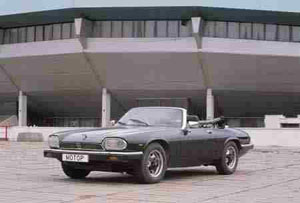 Sometimes, moving in the stream of cars, notice a big and elegant car, which looks like a cat made to the jump.
Sometimes, moving in the stream of cars, notice a big and elegant car, which looks like a cat made to the jump. Easily recognizable in any modification and any age, this car due to the rapid outlines, confident movement, excellent dynamics and some features that I want to be called the grace, quite meets your proud Jaguar name. This is perhaps the most famous in Russia after the Land Rover British brand.
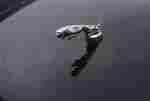 Popularity and high reputation These cars won their excellent design, quality, power and sophistication, which is inherent in many English models, but Jaguar manifests itself particularly bright. Jaguar cars can be written for a long time and a lot, identify poems and poems. This time, in connection with the onset of summer and the opening of the convertible season, we represent the XJSC.
Popularity and high reputation These cars won their excellent design, quality, power and sophistication, which is inherent in many English models, but Jaguar manifests itself particularly bright. Jaguar cars can be written for a long time and a lot, identify poems and poems. This time, in connection with the onset of summer and the opening of the convertible season, we represent the XJSC. Jaguar XJS Cabriolet was made on the basis of the XJS coupe, which came to replace the legendary Jaguar E-Type. The car was born in the most severe conditions of the crisis in the British automotive industry and the oil worldwide, caused by the 1973 war in the Middle East. At that time, the existence of Jaguar was the very issue of the company, because with a sharp increase in gasoline prices, car manufacturers with 12-cylinder engines are experiencing not the best times. Nevertheless, the release of the new car was recognized appropriate, and the world received another car, which after 20 years from the beginning of production was recognized as classic.
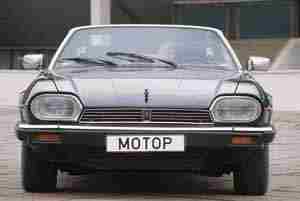 The main goat manufacturers of XJS when discussing the issue of the production of a new car was the presence of a finished serial engine with a volume of 5.3 liters, which was the standards of those years of the riding perfection, for the design of which considerable money was already spent. According to the elements of the suspension and transmission, the new coupe was as unified with the already produced sedan XJ6. It remained only to make an original body and release a car to the market.
The main goat manufacturers of XJS when discussing the issue of the production of a new car was the presence of a finished serial engine with a volume of 5.3 liters, which was the standards of those years of the riding perfection, for the design of which considerable money was already spent. According to the elements of the suspension and transmission, the new coupe was as unified with the already produced sedan XJ6. It remained only to make an original body and release a car to the market. Presented at the 1975 Motor Show, a novelty from Jaguar caused shock. The journalists sought in the invention of the derogatory epithets in the address of the car, said that on both sides of the Atlantic had not yet been such an ugly car, accused of designers in retreat from traditions, the lack of unity of the style, in violation of proportions and other mortal sins. Meanwhile, the XJS possessed a very low aerodynamic resistance coefficient - 0.39, a truly powerful and strong engine - 285 liters. With. and excellent dynamics - 7 seconds. up to 100 km / h And with unusual forms, consumers quickly completed, seeing their grace and proportionality.
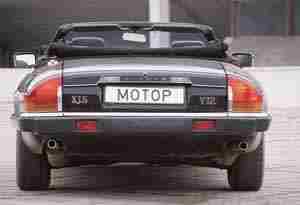 The only fair reprocession to Jaguar, which did not refute the time, was the statement that with the birth of the XJS, the company put the cross on the production of sports cars. Because the sports compartment was offered only with an automatic transmission. More precisely, the versions with the mechanics existed, but it was not even an option, but special order. What is not surprising, because the car was focused primarily on the American market, where automatic transmission is adopted, and manual boxes were installed on single machines mainly in order to designate their presence in the gamma or provide a mechanical version for competitions and tests with meticulous journalists forming the image of the brand .
The only fair reprocession to Jaguar, which did not refute the time, was the statement that with the birth of the XJS, the company put the cross on the production of sports cars. Because the sports compartment was offered only with an automatic transmission. More precisely, the versions with the mechanics existed, but it was not even an option, but special order. What is not surprising, because the car was focused primarily on the American market, where automatic transmission is adopted, and manual boxes were installed on single machines mainly in order to designate their presence in the gamma or provide a mechanical version for competitions and tests with meticulous journalists forming the image of the brand . After spending XJS restyling in 1976, the 3-step automatic machine from BORG-Warner was replaced by GM TNM400, exactly the same as on Rolls-Royce, and the manual box was proposed as an option. However, it did not affect the conjuncture, and for 10,000 cars sold had only 200 with a manual gearbox.
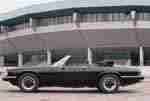 In 1981, due to the next increase in fuel prices and the tightening of the norms of toxicity, the famous 12-cylinder 5.3 liters was subjected to improved. engine. Cylinder heads were upgraded, the intake system was improved and the compression ratio was increased, and the motor itself began to be manufactured on precision equipment. As a result, the power increased to 300 liters. p., Dynamics up to 6.5 sec., And fuel consumption decreased by 12.5%. The forced engine received not the designation not - High Efficiency (highly efficient).
In 1981, due to the next increase in fuel prices and the tightening of the norms of toxicity, the famous 12-cylinder 5.3 liters was subjected to improved. engine. Cylinder heads were upgraded, the intake system was improved and the compression ratio was increased, and the motor itself began to be manufactured on precision equipment. As a result, the power increased to 300 liters. p., Dynamics up to 6.5 sec., And fuel consumption decreased by 12.5%. The forced engine received not the designation not - High Efficiency (highly efficient). Since 1983, part of the Jaguar XJS cars began to equip 6-cylinder engines of 3.6 liters. In 1991, the volume of 6-cylinder increased to 4 liters, and 12-cylinder - up to 6 liters, but 5.3 V12 is still classic.
Until 1985, Jaguar XJS was released only with the body coupe. The British have long been ready for the release of the convertible, but the main consumer of these cars was America, and federal safety standards on the US roads prohibited the operation of open vehicles. In 1985, the rules were changed than the automakers immediately took advantage of, including Jaguar, instantly offered their car. The success of the convertible exceeded all expectations. The XJS Topless began to enjoy mad popularity, and only a considerable price prevented him to become a cult machine of America along with Corvette and Mustang.
We have been looking for this car for a test drive for a long time, and so lucky - he is in front of us. The first impression is to what is small, just a kitten compared to the Daimler Six standing nearby (Analog Jaguar XJ6). However, the impression is deceptive, the XJSC is not at all a small car, just very low - even with an adult to a raised to an adult only a belt. A convertible, unlike the XJS 2 + 2 coupe, a strictly double car, but from the basic version he inherited long doors, so planting on a very convenient, although the low chair does not cause any problems. Ergonomics are excellent, the body occupies the only correct position.
Seat covered with soft skin, have two standard adjustments, plus pneumatic podaching of pillows and lumbar backrest.
I don't want to leave them at all.
First of all, of course, it is necessary to learn awning. Two latches on the upper frame of the windshield open manually, then the key on the center console is driven by the electric drive - the roof of the seconds for twenty silently folds behind the back. If you delay your finger on the button, then after the tender, the rear side windows are removed along with the symbolic central framework. Power windows in the doors are also electric.
Hands on the steering wheel, legs on the pedal, look forward. The ram is covered with the skin, on the touch warm and velvety, the cross section is optimal, the diameter - what needs, and the needles do not interfere with the survey of the instruments. Before the eyes of the speedometer, digitized up to 260 km / h, and the tachometer is up to 7000 revolutions, between them the four pointer of the engine operation parameters with original vertical scales. All figures on devices are drawn clearly, read very easily. Light control is carried out using a rotating handle near the steering column. On the dashboard is very bright - so it can be seen even in the sun - the characters corresponding to the included consumers are displayed. Steal switches control: left - turn signals, right - wiper.
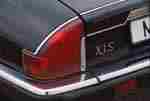 Pedals do not need to look, they are located perfect. In the central part of the front panel, the onboard computer display is under the heater deflectors.
Pedals do not need to look, they are located perfect. In the central part of the front panel, the onboard computer display is under the heater deflectors. Even below, there is a jack for an audio system of impressive sizes and with such an abundance of wires that doubts arise: this car is or recording studio? They are enhanced at the sight of an impressive set of huge speakers behind the seats. Unfortunately, the radio did not have a car in the car, and we could not appreciate the quality of acoustics. On the right and to the left of the music center are rotating climatic installation regulators with automatic and manual modes. The horizontal part of the central console is the automatic gearbox selector, two ashtrays and the above-mentioned control keys of the awning and glasses. All finishing front panel is made of wood with a pronounced beautiful texture.
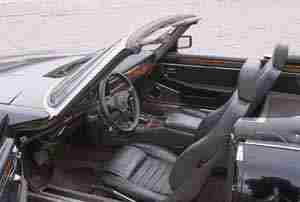 Acquaintance with the management bodies takes a few seconds, fitting the chair and rear-like mirrors larger than. It was not very easy to pull the seat belt. For this you have to turn around the entire body back, since the belt is reinforced far beyond the back of the seat. This should discipline, because it is impossible to fasten into the go, noting the traffic cop, it is impossible in this car.
Acquaintance with the management bodies takes a few seconds, fitting the chair and rear-like mirrors larger than. It was not very easy to pull the seat belt. For this you have to turn around the entire body back, since the belt is reinforced far beyond the back of the seat. This should discipline, because it is impossible to fasten into the go, noting the traffic cop, it is impossible in this car. The motor starts instantly, the bass rocity is delighted. When you press the accelerator pedal, the sound does not become louder, only a slightly changing tonality: the higher the turnover, the higher the timbre. I smoothly talk to the place, first I want to rummage, feel the car. Jaguar obediently responds to the slightest driving movements and pedals, but behaves very solid, without provoking on rapid acceleration, but giving it to understand that much on his shoulder. Since 80% of the torque engine develops at 1500 rpm., The most minor acceleration becomes like a jerk. Populating around the narrow streets, roll out on a straight desert road. Now it's time to break away.
Pedal to the floor, I am pressed into the back of the chair. The wind whistle in the ears muffles all other sounds. The air flow breaks into the lungs, not allowing to do exhale. Full feeling of free flight. And the acceleration is quite comparable to the fall. Trees along the edges of the road merge into one solid strip, passing cars rush to the right at such speed, as if they travel to meet. Large work was worth the eyes from the road and take a look at the speedometer. The arrow fell for 200. This is probably too much! After all, the task of our test is not to establish a speed record for Russian roads or experience your body for wind resistance, and feel the beauty of the trip on an open car in a warm sunny day. Reset up to 90 km / h.
In the cabin still walks the wind. 80 - the speed is optimal. With it, the air flow is cut off with a windshield without twist and inside the car there are no drafts. It becomes a distinguishable sound of the engine, but the tires are loudly louder. It is quite justified by the presence of huge audio colors - to listen to music while leaving the roof, it should be loud and sound clearly. Lightly saves the city landscape (the window does not fit here).
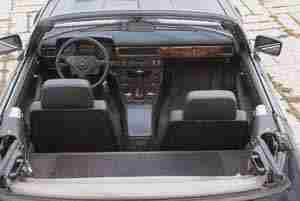 The sun is capeting. The desire disappears somewhere to rush, spit the engine and dissect space with a whistle. I would like to move leisurely, enjoying comfort, and stretch pleasure. On the way back the weather spoiled a little, and I had to return with the risen. In this case, the car does not differ from the Hardtop version. In the salon, the silence, violated only by the rumble of a powerful engine, at any speed, a single jet of air does not break through the seals, and the rear window (present, and even heated) provides a good overview.
The sun is capeting. The desire disappears somewhere to rush, spit the engine and dissect space with a whistle. I would like to move leisurely, enjoying comfort, and stretch pleasure. On the way back the weather spoiled a little, and I had to return with the risen. In this case, the car does not differ from the Hardtop version. In the salon, the silence, violated only by the rumble of a powerful engine, at any speed, a single jet of air does not break through the seals, and the rear window (present, and even heated) provides a good overview. 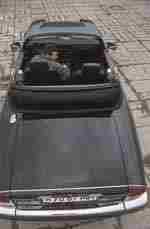 Jaguar's running quality is above all praise. The energy-intensive suspension perfectly processes all the irregularities of the road. Neither the vibration nor the impulse on deep potholes are transmitted. The engine and transmission work so nicely that the car accelerates in a single impulse, it is impossible to feel the switch. The car is managed easily and confidently: when we fell to an improvised by a car with a placed slagistic route, Jaguar passed it one and a half times faster than the rest of the cars (not the worst). Powerful and efficient brakes make this car absolutely safe when moving on any (of course, reasonable) speeds.
Jaguar's running quality is above all praise. The energy-intensive suspension perfectly processes all the irregularities of the road. Neither the vibration nor the impulse on deep potholes are transmitted. The engine and transmission work so nicely that the car accelerates in a single impulse, it is impossible to feel the switch. The car is managed easily and confidently: when we fell to an improvised by a car with a placed slagistic route, Jaguar passed it one and a half times faster than the rest of the cars (not the worst). Powerful and efficient brakes make this car absolutely safe when moving on any (of course, reasonable) speeds. In short, this is a pleasure car, for walking with your girlfriend, when only the sky above your head, for a trip for the city, when nothing prevents the scenery and breathe the aroma of fresh air. And at the same time, this is a serious and very powerful car with a pronounced sports character - whatever they say about automatic gearbox.
Evgeny Romantsky
A source: Magazine Motor [№7 / 1997]

